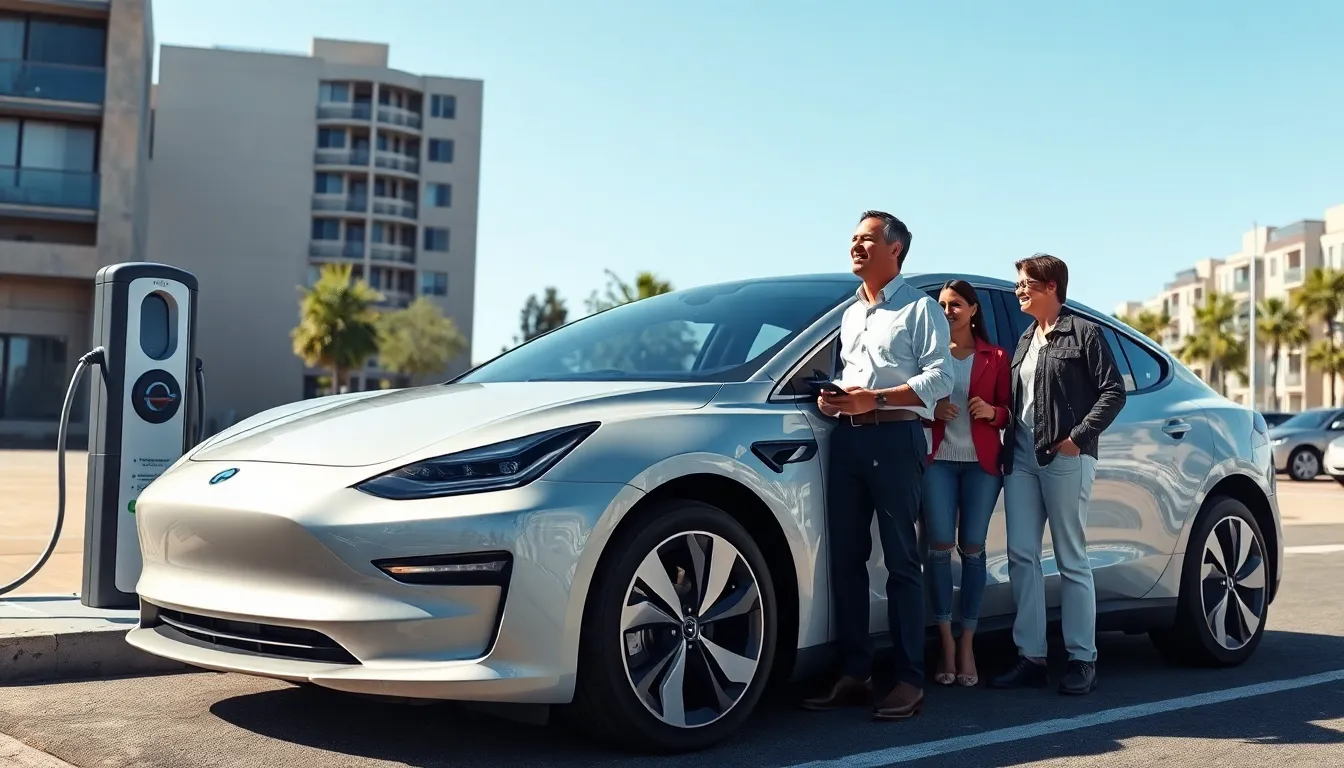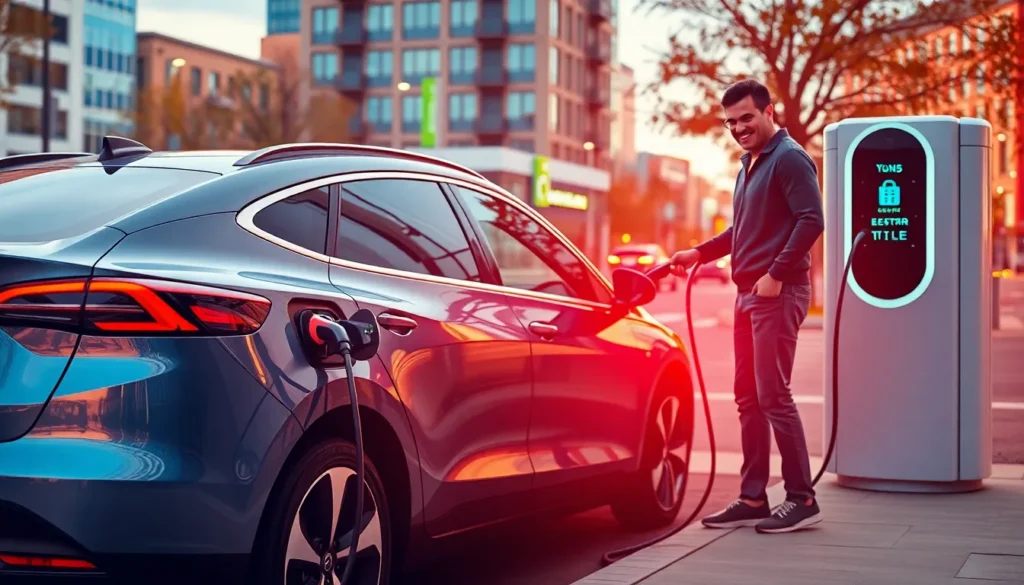In 2020, electric vehicles (EVs) zoomed into the spotlight, turning heads faster than a sports car at a red light. With a growing awareness of climate change and the need for sustainable solutions, these eco-friendly rides became the talk of the town. Gone are the days when EVs were seen as quirky novelties; now they’re sleek, stylish, and packed with tech that would make even the Jetsons jealous.
As drivers traded gas guzzlers for battery-powered beauties, the automotive landscape began to shift. From impressive ranges to rapid charging capabilities, electric vehicles offered a glimpse into a cleaner, greener future. So buckle up and get ready to explore how 2020 paved the way for a revolution on the roads, proving that saving the planet can be both fun and fashionable.
Table of Contents
ToggleOverview of Electric Vehicles 2020
Electric vehicles gained significant traction in 2020, showcasing advanced technology and design. Major manufacturers introduced models that appealed to a broader audience, integrating sleek aesthetics with powerful performance. The growing emphasis on sustainability influenced buyers to consider eco-friendly alternatives.
Long ranges became a standard feature, with many EVs offering over 250 miles on a single charge. Fast charging options emerged, allowing owners to recharge batteries in as little as 30 minutes at select stations. Overall, the user experience for EV owners improved, with added services and supported infrastructure development.
Government incentives, such as tax credits and rebates, boosted EV adoption rates. Increased awareness of climate change created a shift in consumer behavior towards sustainable choices. Data from the International Energy Agency indicated that EV sales surged to about 3 million units globally, nearly doubling from the previous year.
Public charging networks expanded significantly, enhancing convenience for electric vehicle owners. Many cities committed to installing more charging stations to accommodate a growing number of electric cars on the road. As a result, urban planning increasingly integrated EV-friendly infrastructure into future developments.
In 2020, the automotive industry faced challenges and opportunities. Traditional manufacturers and startups alike competed within the dynamic EV market, driving innovation. With consumer interest surging, manufacturers focused on refining battery technologies and reducing costs to enhance market appeal.
The electric vehicle landscape transformed rapidly. Amidst increasing urgency for sustainable transportation, 2020 set a precedent for future growth and development in the automotive sector.
Key Trends in Electric Vehicles 2020

Electric vehicles (EVs) gained significant momentum in 2020, reshaping the automotive landscape as consumers embraced sustainable transportation options.
Increased Adoption Rates
Sales of electric vehicles surged globally, reaching around 3 million units in 2020. This figure nearly doubled from the previous year, driven by growing consumer awareness and government incentives. Tax credits and rebates played a crucial role in stimulating EV sales, making these vehicles more accessible. Major automakers introduced diverse models that appealed to a broader audience, enhancing mainstream acceptance. Local governments supported expansion of public charging infrastructure, making it easier for owners to charge their vehicles. As a result, a shift towards electrification reflected not only environmental concerns but also a growing trend for innovative automotive technologies.
Advances in Battery Technology
Battery technology made significant strides in 2020, enhancing the overall performance of electric vehicles. Manufacturers focused on increasing energy density, allowing EVs to achieve longer ranges. Many new models offered over 250 miles on a single charge, instilling consumer confidence in electric options. Fast charging capabilities also improved, with some vehicles gaining the ability to recharge in about 30 minutes. Innovations in battery materials, like solid-state batteries, showed promise for future development. These advancements showcased a commitment to refining energy solutions, ultimately leading to cost reductions and extended lifespans for batteries. Enhanced battery technology underscored a pivotal aspect of the ongoing evolution in the electric vehicle market.
Major Players in the Electric Vehicle Market
The electric vehicle market in 2020 showcased a diverse range of automakers delivering innovative solutions. Major brands such as Tesla, Nissan, and Chevrolet led the charge with models that combined style and performance.
Automaker Innovations
Automakers unveiled advancements that pushed electric vehicles into the mainstream. Tesla debuted the Model Y, boasting a range of 300 miles and impressive acceleration. Ford introduced the Mustang Mach-E, merging iconic design with electric efficiency, appealing to a wider audience. Volkswagen launched the ID.4, emphasizing sustainability and practicality. These innovations reflected a commitment to enhancing performance alongside aesthetic appeal.
Charging Infrastructure Developments
Charging infrastructure saw extensive growth in 2020, addressing a critical aspect of electric vehicle adoption. Public charging stations expanded dramatically, increasing to over 100,000 locations across the United States. Partnerships between automakers and charging network providers emerged, improving the accessibility of fast chargers. Companies like Electrify America focused on deploying ultra-fast stations capable of charging vehicles to 80 percent in around 30 minutes. This development reassured consumers regarding the convenience of owning an EV, effectively reducing range anxiety.
Government Policies and Incentives
Government policies and incentives significantly impacted electric vehicle adoption in 2020. Tax credits and rebates increased affordability for consumers, making it easier to transition to EVs. These incentives often provided thousands of dollars in savings, encouraging buyers to consider electric options.
Several jurisdictions introduced additional programs aimed at boosting electric vehicle sales. Grants for municipalities and funding for charging infrastructure enhancements appeared across various states. Local governments frequently partnered with manufacturers to expand charging networks, creating vast improvements in convenience.
Regulatory changes also shaped the market landscape. Emission standards tightened, compelling manufacturers to prioritize cleaner technologies. Many automakers invested heavily in electric designs to meet regulatory demands in 2020.
Global initiatives played a role too. Many countries committed to reducing carbon emissions, pushing for a shift away from fossil fuels. Such commitments stimulated investments in electric vehicle technology and infrastructure development worldwide.
Furthermore, some states implemented zero-emission vehicle mandates. These requirements ensured that a certain percentage of vehicle sales had to be electric, further increasing market pressure on automotive companies. In response, several manufacturers ramped up their electric offerings, reflecting a broader shift in the industry.
The influence of policies extended beyond just consumer incentives; they prompted manufacturers to innovate. With the backing of governmental support, advancements in battery technology continued to accelerate. Such collaborative efforts laid a stronger foundation for future growth in sustainable transportation.
Overall, the combination of incentives, regulatory support, and public initiatives shaped 2020 as a pivotal year for electric vehicles.
Challenges Facing Electric Vehicles in 2020
High costs remained a barrier for electric vehicles, as the price of many models exceeded those of traditional vehicles. While advancements in technology led to price reductions, consumers faced sticker shock, particularly in early 2020. Range anxiety persisted, as potential buyers worried about battery life and charging availability during longer trips. Charging infrastructure, although improved, required further expansion to meet growing demand, particularly in rural and underserved areas.
Battery production posed environmental concerns, with mining for lithium and cobalt often leading to ecological damage. Manufacturers prioritized efficiency, but the sourcing of raw materials presented challenges in sustainability. Additionally, competition intensified within the automotive market; both traditional manufacturers and startups vied for consumer attention, increasing the pressure to innovate continuously.
Consumer education played a vital role in adoption rates. Many potential buyers lacked awareness about the benefits and technology behind electric vehicles. Misconceptions about performance and reliability hindered acceptance, despite EVs demonstrating significant advancements.
Government policies contributed to both support and challenges. Incentives varied by region, with some areas offering substantial tax credits while others provided minimal support. Regulatory compliance created obstacles as manufacturers navigated changing emission standards and environmental regulations. Navigating these complexities often consumed resources that could’ve been directed toward development and marketing.
Infrastructure readiness remained uneven across the U.S. Urban areas saw a surge in charging stations, yet rural communities faced considerable deficits. This disparity affected consumer confidence, as concerns about access and convenience continued to loom. Addressing these challenges required collaborative efforts among stakeholders, including automakers, governments, and technology providers.
The electric vehicle landscape in 2020 marked a significant turning point for the automotive industry. With impressive advancements in technology and growing consumer interest, EVs emerged as a viable alternative to traditional vehicles. The combination of stylish designs and enhanced performance captured the attention of a broader audience, while government incentives and expanding charging infrastructure made ownership more accessible.
Despite the challenges that remain, including high costs and infrastructure disparities, the momentum behind electric vehicles is undeniable. As manufacturers continue to innovate and address consumer concerns, the future looks promising for sustainable transportation. The groundwork laid in 2020 sets the stage for further growth and acceptance of electric vehicles in the years to come.





